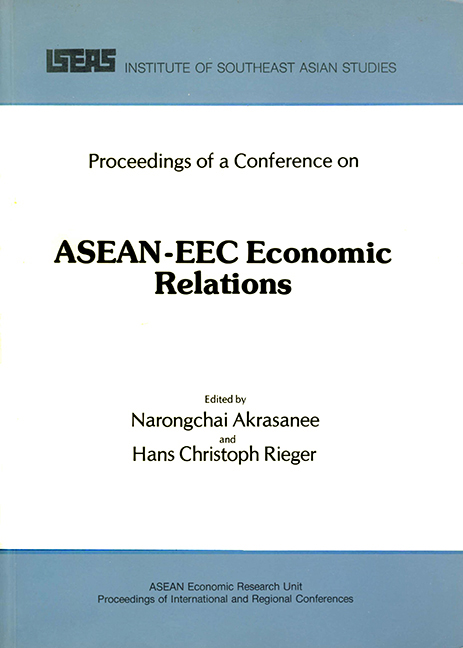Book contents
- Frontmatter
- Contents
- FOREWORD
- BUILDING BRIDGES AND OPENING DOORS
- 1 TRADE
- ASEAN-EC Trade Relations: An Overview
- Trends of EC Protection and the Prospects of ASEAN Trade
- Issues Relating to the EC's Imports of ASEAN Primary Products
- ASEAN Manufactured Exports in the EC Markets: An Empirical Assessment of Common and National Tariff and Non-Tariff Barriers Confronting Them
- A Constant-Market-Shares Analysis of ASEAN Manufactured Exports to the EC
- II INVESTMENT
- APPENDICES
A Constant-Market-Shares Analysis of ASEAN Manufactured Exports to the EC
from 1 - TRADE
Published online by Cambridge University Press: 21 October 2015
- Frontmatter
- Contents
- FOREWORD
- BUILDING BRIDGES AND OPENING DOORS
- 1 TRADE
- ASEAN-EC Trade Relations: An Overview
- Trends of EC Protection and the Prospects of ASEAN Trade
- Issues Relating to the EC's Imports of ASEAN Primary Products
- ASEAN Manufactured Exports in the EC Markets: An Empirical Assessment of Common and National Tariff and Non-Tariff Barriers Confronting Them
- A Constant-Market-Shares Analysis of ASEAN Manufactured Exports to the EC
- II INVESTMENT
- APPENDICES
Summary
INTRODUCTION
The main part of world trade in manufactures is concentrated within the group of OECD countries. For non-OECD market economies, the markets of high-income countries are the main outlets for their export manufactures. During the more than two and a half decades in the post-war era, up to 1973, the OECD countries experienced high rates of growth in per capita income. Growth, international specialization and international trade were stimulated by successive rounds of trade liberalization measures. Indeed, the share of imports in domestic demand and the share of exports in production increased gradually, especially in the EC member states. During this period, labelled by Herman Kahn ‘La Deuxieme Belle Epoque’, the developing countries too experienced a steady growth in their exports of manufactures to the OECD countries, in spite of the fact that the trade liberalization rounds had favoured intra-OECD trade over imports from developing countries. General Schemes of Preference were not yet in force before the seventies. Although OECD imports from developing countries increased by about 15 per cent a year during the sixties, the share of these countries in total OECD imports decreased during this period.
After 1973, the international economic situation changed drastically and many a trend was reversed. Per capita income growth in developing countries, and especially in middle-income countries, exceeded the growth performance of OECD countries. The export growth rates of especially some so-called ‘Newly Industrializing Countries’ (NICs) far surpassed the average growth of manufactures in world trade, and consequently the share of developing countries in world trade in manufactures increased, and so did their share in OECD imports of manufactures. Governments and economic agents in the OECD countries became increasingly reluctant towards further liberalization attempts, especially with respect to ‘sensitive industries’ that faced strong competition from new competitors.
Notwithstanding the deterioration of the economic situation in the OECD countries since 1973 and the reversal in the trends mentioned above, the OECD markets are still the main outlets for developing countries' exports in the seventies, and will continue to be so throughout the eighties.
- Type
- Chapter
- Information
- ASEAN-EEC Economic Relations , pp. 194 - 254Publisher: ISEAS–Yusof Ishak InstitutePrint publication year: 1981



